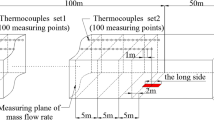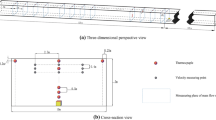Abstract
This paper focuses on the smoke transport lag time at the early stage of fires in long-narrow spaces, which is defined as the time from fire onset to the time when smoke reaches a given position on the ceiling. For a heat detector at a specific location on the ceiling, the smoke transport lag time is a part of the response time of the heat detector. Especially when the heat release rate is relatively small at the early stage of fires, the smoke transport lag time will be very long, which will hence lead to the increase of heat detector response time. It is clear that the prediction of smoke transport lag time is critical to the activation time of the heat detector. However, previous studies have much focused on fire characteristics in long-narrow spaces, leaving very few on the transport time lag. Therefore, in this study, a theoretical model regarding smoke transport time lag was developed for both steady and time-dependent fires based on the weak-plume theory. This model was validated by a series of reduced-scale experiments. It can be concluded from comparison that the predictions of this model agree reasonably well with the corresponding experimental results. Using the proposed method, the dimensionless equations of smoke transport time lag, velocity and temperature considering the smoke lag effect in a long-narrow space for time-squared fires were also theoretically deduced. Additionally, to further determine the applicability of ‘Quasi-steady’ state assumption for time-squared fires, a calculation method regarding the critical time was also developed. The outcomes from this study will be beneficial to the development of fire detection model in long-narrow spaces.














Similar content being viewed by others
References
Alpert RL (2002) Ceiling jet flows. In: SFPE handbook of fire protection engineering, 3rd edn. National Fire Protection Association, Inc., Quincy, 2-18–2-20
Alpert RL (1972) Calculation of response time of ceiling-mounted fire detectors. Fire Technol 8(3):181–195. doi:10.1007/BF02590543
Alpert RL (1975) Turbulent ceiling-jet induced by large-scale fires. Combust Sci Technol 11(5–6):197–213. doi:10.1080/00102207508946699
Heskestad G (1975) Physical modeling of fire. J Fire Flammabl 6:253–273
Alpert RL, Ward EJ (1984) Evaluation of unsprinklered fire hazards. Fire Safety J 7(2):127–143. doi:10.1016/03797112(84)90033-X
Heskestad G, Delichatsios MA (1979) The initial convective flow in fire. In: Seventeenth symposium (international) on combustion. Combustion Institute, Pittsburgh. 17(1) 1113–1123. doi:10.1016/S0082-0784(79)80106-X
Heskestad G, Delichatsios MA (1989) Update: the initial convective flow in fire. Fire Saf J 15(6):471–475. doi:10.1016/0379-7112(89)90017-9
GB50116-2013 (2013) Code for design of automatic fire alarm system, National standard of the People’s Republic of China
NFPA 13 (2013) Standard for the installation of sprinkler systems, National Fire Protection Association, Quincy
Delichatsios MA (1981) The flow of fire gases under a beamed ceiling. Combust Flame 43:1–10. doi:10.1016/0010-2180(81)90002-X
Koslowski CC, Motevalli V (1994) Behavior of a 2-dimensional ceiling jet flow: a beamed ceiling configuration. In: Kashiwagi T (ed) Fire Safety Science, Proceedings of the Fourth International Symposium, International Association of Fire Safety Science, Bethesda, pp 469–480. doi:10.3801/IAFSS.FSS.4-469
Koslowski CC, Motevalli V (1993) Effects of beams on ceiling jet behavior and heat detector operation. J Fire Prot Eng 5(3):97–111. doi:10.1177/104239159300500302
Evans DD, Stroup DW (1985) Methods to calculate the response time of heat and smoke detectors installed below large unobstructed ceilings. Fire Technol 22(1):54–65. doi:10.1007/BF01040244
Alpert RL (2002) Ceiling jet flows. SFPE handbook of fire protection engineering. National Fire Protection Association, Inc., Quincy, pp 2–23
Newman JS (1988) Principles for fire detection. Fire Technol 24(2):116–127. doi:10.1007/BF01041337
Mowrer FW (1990) Lag times associated with fire detection and suppression. Fire Technol 26(3):244–265. doi:10.1007/BF01040111
Stroup DW, Evans DD (1988) Use of computer fire models for analyzing thermal detector spacing. Fire Saf J 14(1–2):33–45. doi:10.1016/0379-7112(88)90043-4
Beyler CL (1984) A design method for flaming fire detection. Fire Technol 20(4):5–16. doi:10.1007/BF02389990
Wang JH, Xu T (2013) A new calculation model of detection time for heat detector in long and narrow space. Proc Eng 52:355–362. doi:10.1016/j.proeng.2013.02.153
Wang JH, Jiao Y, Xu LP (2011) An approximate calculation method for response time and arrangement space of ship smoke detectors. China Saf Sci J 21(11):67–71 (in Chinese). doi:10.3969/j.issn.1003-3033
Ji J, Zhong W, Li KY (2011) A simplified calculation method on maximum smoke temperature under the ceiling in subway station fires. Tunn Undergr Sp Technol 26(3):490–496. doi:10.1016/j.tust.2011.02.001
Hu LH, Huo R, Li YZ, Wang HB, Chow WK (2005) Full-scale burning tests on studying smoke temperature and velocity along a corridor. Tunn Undergr Sp Technol 20(3):223–229. doi:10.1016/j.tust.2004.08.007
Li SY, Zong RW, Zhao WF, Yan ZH, Liao GX (2011) Theoretical and experimental analysis of ceiling-jet flow in corridor fires. Tunn Undergr Sp Technol 26(6):651–658. doi:10.1016/j.tust.2011.05.011
Ji J, Fan CG, Zhong W, Shen XB, Sun JH (2012) Experimental investigation on influence of different transverse fire locations on maximum smoke temperature under the tunnel ceiling. Int J Heat Mass Trans 55(17–18):4817–4826. doi:10.1016/j.ijheatmasstransfer.2012.04.052
Li YZ, Lei B, Haukur I (2011) The maximum temperature of buoyancy-driven smoke flow beneath the ceiling in tunnel fires. Fire Saf J 46(4):204–210. doi:10.1016/j.firesaf.2011.02.002
Li LM, Cheng XD, Yu C, Dong WH, Mei ZB (2013) Estimation of smoke arrival time in tunnel fires. Tunn Undergr Sp Technol 38:431–434. doi:10.1016/j.tust.2013.08.002
Yang D, Hu LH, Huo R, Jiang YQ, Liu S, Tang F (2010) Experimental study on buoyant flow stratification induced by a fire in a horizontal channel. Appl Therm Eng 30(8–9):872–878. doi:10.1016/j.applthermaleng.2009.12.019
Yang D, Huo R, Zhang XL, Zhao XY (2011) Comparison of the distribution of carbon monoxide concentration and temperature rise in channel fires: reduced-scale experiments. Appl Therm Eng 31(4):528–536.doi:10.1016/j.applthermaleng.2010.10.011
Yang D, Huo R, Zhang XL, Zhao XY (2011) On the front velocity of buoyancy-driven transient ceiling jet in a horizontal corridor: comparison of correlations with measurements. Appl Therm Eng 31(14–15):2992–2999. doi:10.1016/j.applthermaleng.2011.05.031
Motevalli V, Yuan ZP (2008) Steady state ceiling jet behavior under an unconfined ceiling with beams. Fire Technol 44(2):97–112. doi:10.1007/s10694-007-0027-3
Mortem BR, Taylor GI, Turner JS (1956) Turbulent gravitational convection from maintained and instantaneous sources. Proc R Soc A 234(1196):1–23.doi:10.1098/rspa.1956.0011
Zukoski EE, Kubota T, Cetegan B (1980) Entrainment in fire plumes. Fire Saf J 3(3):107–121. doi:10.1016/0379-7112(81)90037-0
Holborn P, Nolan P, Golt J (2004) An analysis of fire sizes, fire growth rates and times between events using data from fire investigations. Fire Saf J 39(6):481–524. doi:10.1016/j.firesaf.2004.05.002
Tanaka T, Fujita T, Yamaguchi J (2000) Investigation into rise time of buoyant fire plume fronts. Int J Eng Perform Fire Codes 2(1):14–25
Liu X, Xu S, Lu S et al.(2004) Analysis and design of similarity model of ship fire simulation cabin. Fire Sci Technol 23(5):413–417
Acknowledgment
The authors would like to thank the anonymous reviewers and the editor-in-chief for their constructive suggestions and help in improving this paper. This work was financially supported by the National Natural Science Foundation of China (Grant Nos. 50909058, 71503166), Natural Science Foundation of Shanghai (Grant No. 16ZR1414600), and Shanghai Municipal Education Commission First-class Disciplines Project, Innovation Project of Shanghai Graduate Education (Grant No. 20131129).
Author information
Authors and Affiliations
Corresponding author
Rights and permissions
About this article
Cite this article
Wang, J., Li, G., Shi, L. et al. Transport Time Lag Effect on Smoke Flow Characteristics in Long-Narrow Spaces. Fire Technol 53, 983–1010 (2017). https://doi.org/10.1007/s10694-016-0614-2
Received:
Accepted:
Published:
Issue Date:
DOI: https://doi.org/10.1007/s10694-016-0614-2




